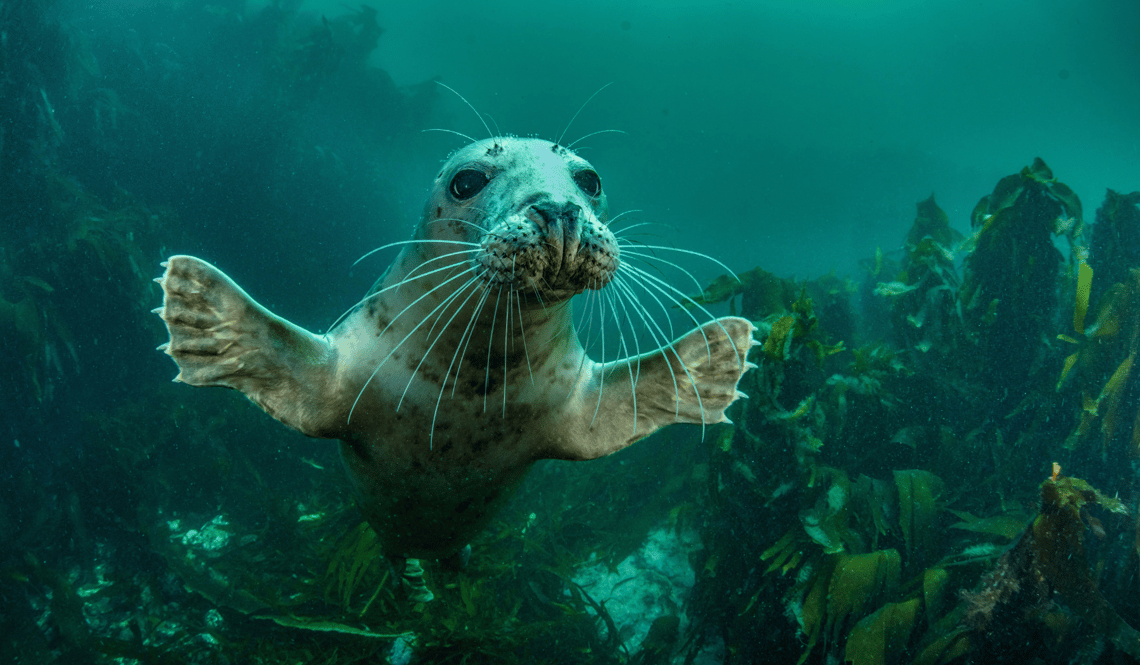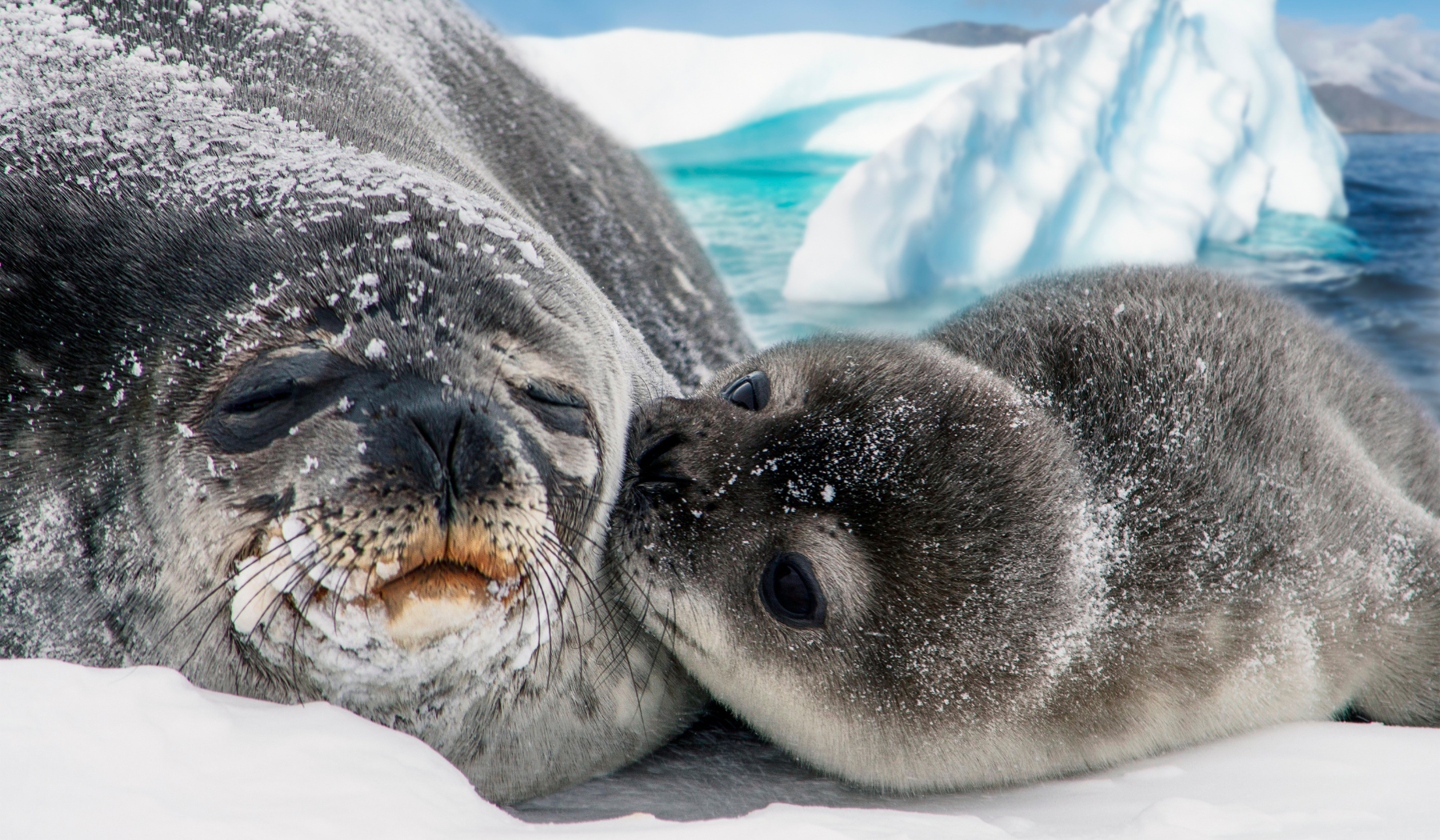Seals have it pretty good. They seem to enjoy an idyllic lifestyle, spending most of their days eating a generous spread of seafood or lazing about in some of the world’s most magnificent landscapes, such as the cold waters of Antarctica and the Arctic. Seals are cute and comical, and the many vocalizations they make are sure to amuse you if you ever get close enough to a colony.
There are 33 species of seals, and we’re lucky to encounter many of these on our polar cruises, including the leopard seal, crabeater seal, and Weddell seal in Antarctica, and the bearded seal in the Arctic.
It’s best to observe seals from the Zodiac, ship, or shore, and allow at least 15 meters between you. Due to the variety of species and their habits, there’s a chance of seeing seals year-round, either in the water or lounging on land or ice. In Antarctica, between September and January is a good time to see seals on the ice when they are breeding or giving birth. In the Arctic, there are opportunities to see seals between June and August, once the ice had melted.
Let’s get to know these unique creatures with 10 facts that might surprise you.
1) Seals are distantly related to bears and skunks

Seals. Source: Canva
Seals are part of the pinniped order of animals, which also includes walruses and sea lions. Pinniped means “fin-footed” in Latin, and explains why all these semi-aquatic animals are such tremendous swimmers. Evolutionary biologists have traced the origins of pinnipeds back to meat-eating land mammals that also evolved into bears, otters, badgers and skunks. In 2007, a skeleton of a previously unknown semi-aquatic carnivore was discovered in Nunavut, Canada, and was thought to demonstrate the link between land mammals and pinnipeds.
2) Seals come in different shapes and sizes

Harp Seal. Source: Canva
Most seals have in common a thick layer of fat, known as blubber, to keep them warm in cold waters. The variety across the 33 species of seals is immense, especially when it comes to size. The smallest species is the Galapagos fur seal, which is a meter in length and has an average weight of 45 kilograms. Contrast that with the southern elephant seal, which can be more than 5 meters long and whose males weigh in at a stunning 4,000 kilograms! There is even one freshwater seal, the Baikal seal which is native to Lake Baikal in Siberia. Of all the species, the crabeater has the largest population, with estimates between 7 and 15 million, but some scientists projecting that 75 million crabeater seals are alive and well, hanging out in Antarctica at this very moment. If true, that would put the crabeater population somewhere between France and Germany.
3) Earless seals have ears

An "earless" seal. Source: Canva
Seals are sometimes referred to as “true seals” or “earless seals” to distinguish them from sea lions, who have visible ears on the sides of their heads. But “true seals” (phocids) due in fact have ears, they just are not ones you can see. Covered by the surface of their skin, these seals have a tiny opening that allows them to hear. In fact, they are thought to be able to hear higher frequencies than sea lions (otariids) when underwater, while the reverse is true on land when sound is traveling through the air.
4) Seals are chatty

Leopard Seal. Source: Canva
On the topic of seals’ ability to hear, it’s natural to discuss how much they like to talk. Barking, growling, grunting, chirping, clicking, and even whistling make up the repertoire of seal vocalizations. Some of the sounds they make are not even audible to the human ear, including ultrasonic calls made underwater. The Weddell seal is thought to have the most elaborate set of vocalizations, one that appears to have complexities such as prefixes and suffixes and rhythmic patterns. Within species, there are even thought to be geographic differences, similar to dialects. And what are all these seals talking about? Well, they vocalize to warn about predators, while playing, or to help them along in the mating process. There is also research that shows a mother and her cub recognize one another through their call, even after a separation of years. Along with being a noisy bunch, they communicate by slapping their flippers, chattering their teeth, and flaring their nostrils or showing off their stripes.
5) Seals love the water

A seal enjoying the water. Source: Canva
The amount of time seals spend in the water varies depending on the species and the season. In winter, some species spend as much as 80% of their time in the sea, while most species come out onto the land in spring and summer to molt or give birth and nurse pups. Some seal species make long migrations, such as the northern fur seal which takes a 10,000-kilometer round-trip swim in the Bering Sea. Seals can dive up to 900 meters, often in search of food, and species such as the northern elephant seal spends most of its time at that depth, only coming up to the surface for a few minutes before diving down again. Some seals can hold their breath for up to two hours underwater by conserving oxygen and slowing their heart rate.
6) Seals can sleep in unusual places
.jpg?width=1800&height=1050&name=POL%20(1).jpg)
Weddel Seal sleeping. Source: Canva
Seals spend most of their time in the water, coming onto land usually to just mate, give birth, eat, or molt. When it comes to getting some shut-eye, a seal can do so either on land or in the water. Research has shown seals sleeping for several minutes as they plunge downward, belly-up. They keep one half of their brain awake so that they are aware of predators such as sharks. When they catch some z’s on land, they’re able to turn their whole brain off and get a deep rest.
7) Seals have a complicated love life

Crabeater Seal. Source: Canva
Most seals live in large groups known as colonies. While they all live tightly packed together on a piece of land or sea ice, they aren’t exactly close. Think of it like a big city where you know but aren’t necessarily friends with your neighbors. Of the 33 species, 20 of these breed on land, while the other 13 breed on ice. The land-breeders are polygynous, meaning one male has many partners in a large group of females. Often, this takes place at the same site, such as an island where there is little danger of predators. The male will show up and wait for the females to arrive, then mate with as many as he can, often even forgoing food as to leave might mean he loses his domination of the group. Males defend their territory with threatening vocalizations, but rarely are their physical fights. At times, the same male can keep his territory for months at a time. A study in the Falkland Islands of elephant seals showed that, in one colony, more than 90% of the pups were fathered by one male. Not only that, but nearly three-quarters of the other males were not observed to have any romantic success. Some male elephant seals have been known to sneak into female groups and try to blend in by pulling in their noses to see if they can get lucky.
8) Seals love to eat

A seal enjoying its meal. Source: Canva
Seals don’t get to be up to 4 tons by watching their waistlines. Larger seals might eat as much as 4 or 5 kilograms of food a day. Their favorite food is seafood and they can eat a lot of it. Fish, squid, mollusks, shrimp, crustaceans, and zooplankton organisms are all on the menu. Seals are opportunistic rather than picky eaters. They’ve been known to eat seabirds, penguins, and, alas, even other seals. Seals are mostly solitary hunters. They will consume their prey whole while underwater, unless it is too large, in which case they bring it to the surface to take apart on the land or ice. Their appetites likely originate in their puphood, with the milk they consumed from their mother containing up to 50% fat, making them gain as much as 2 kilograms a day. Once matured, the energy that’s stored in their blubber allows them to fast for longer periods, essential in cases such as when they are mating and don’t want to risk leaving their dates alone for even a minute.
9) Seals are playful, smart, and slightly mischievous
.jpg?width=1800&height=1050&name=Seal%20(2).jpg)
Source: Canva
It has been common for sea lions to be used in performances where they entertain a crowd by balancing balls on their noses and other similar trained acts. In fact, seals have been taken into captivity since Ancient Rome; even Pliny the Elder makes a remark on how easily they are trained. Humans have often found seals entertaining because they are so playful and friendly, and now there is action by groups such as World Animal Protection that discourage keeping seals in captivity at all. Researchers have discovered a high level of intelligence in pinnipeds, including the ability to understand syntax in a form of sign language, comprehend patterns and symmetry, and the capacity to mimic the timbre of their rivals’ calls. There are many tales of seals being mischievous, such as an elephant seal in New Zealand who overturned parked cars in town, or a colony that took over a town in Newfoundland, Canada. They have been known to photo-bomb deep-sea divers, or remove their mouthpieces or diving caps.
10) There is a day that celebrates seals

Source: Canva
March 22 is the International Day of the Seal. The holiday was established in 1982 and aims to bring awareness to the problems that face seals and the importance of protecting them. Throughout history, seals have been targeted for their fat and fur, and several species have already become extinct. Climate change also threatens seal species, especially those that depend on sea ice. This year, celebrate the Day of the Seal by thinking about how unique and extraordinary the seal is, and how vital it is that we preserve its habitat so it can keep living the good life, both deep in the sea and upon the land.
If you adore seals as much as we do, check out our cruises to both the Arctic and Antarctica where we see several species in their natural habitats. At Polartours, our filters even let you search according to what animals you want to see, so you can find a cruise with the ultimate pinniped “seal of approval.”




